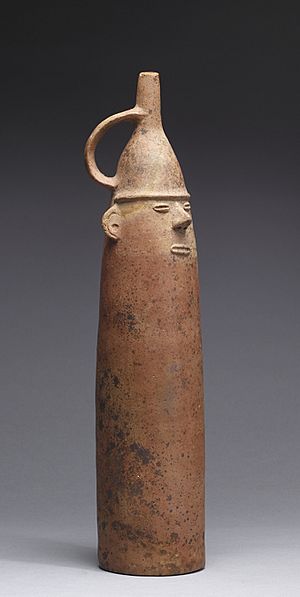Salinar culture facts for kids

Map of the Salinar culture
|
|
| Geographical range | Ancash |
|---|---|
| Period | Early Intermediate |
| Dates | c. 200 BCE - 300 CE |
| Type site | Cerro Arena |
| Preceded by | Casma–Sechin, Chavín |
| Followed by | Moche, Virú |
The Salinar culture was an ancient civilization in Peru. It grew along the coast in the areas now known as Ancash and La Libertad.
This culture existed from about 200 BCE to 300 CE. It came after the Chavín people and before the Moche and Virú civilizations. The Salinar culture was an important bridge between these two big periods in ancient Peruvian history.
Contents
What Was the Salinar Culture Like?
When the Chavín culture started to fade, smaller groups along the north coast of Peru came together. These groups formed the Salinar culture. They made big improvements to their farming. They built more irrigation systems, which are ways to bring water to crops. This helped them grow much more food.
Where Did the Salinar People Live?
Most Salinar settlements were small villages. But some places grew into larger towns. One important site is Cerro Arena, located in the Moche Valley. This was a very large town, covering about 2 square kilometers. It had around 2,000 stone buildings. These buildings included homes, places for ceremonies, and administrative centers where leaders worked.
The Salinar people also built strong forts on top of hills. These forts protected their towns. This shows that there were many wars during the time the Salinar culture existed. Everyone in the community likely took part in defending their homes.
How Did They Build Their Homes and Tombs?
The Salinar people used special bricks called "odontiform adobes." These bricks were shaped by hand. Their houses were usually square with low walls and wooden posts.
When someone died, they were buried in long, oval-shaped graves. The bodies were laid out with their legs crossed and leaning to the right. They were wrapped in cloth and buried with jewelry and ceramic pots. Often, a piece of gold foil was placed in their mouth.
Art and Craftsmanship of Salinar
The Salinar culture is known for its unique pottery and metalwork.
Salinar Pottery
The pottery of the Salinar culture changed over time. Early pieces were often black. Later, they started making red pottery with white paint. They made special bottles with a stirrup handle, which looks like a loop. They also created new "figurine bottles" that looked like people or animals, with a bridge handle connecting two spouts.
Metalwork and Tools
The Salinar people were skilled miners. They mined copper, a type of metal. They also learned to mix copper with gold. This created a new metal alloy, which they used to make different objects.
See also
 In Spanish: Cultura salinar para niños
In Spanish: Cultura salinar para niños


